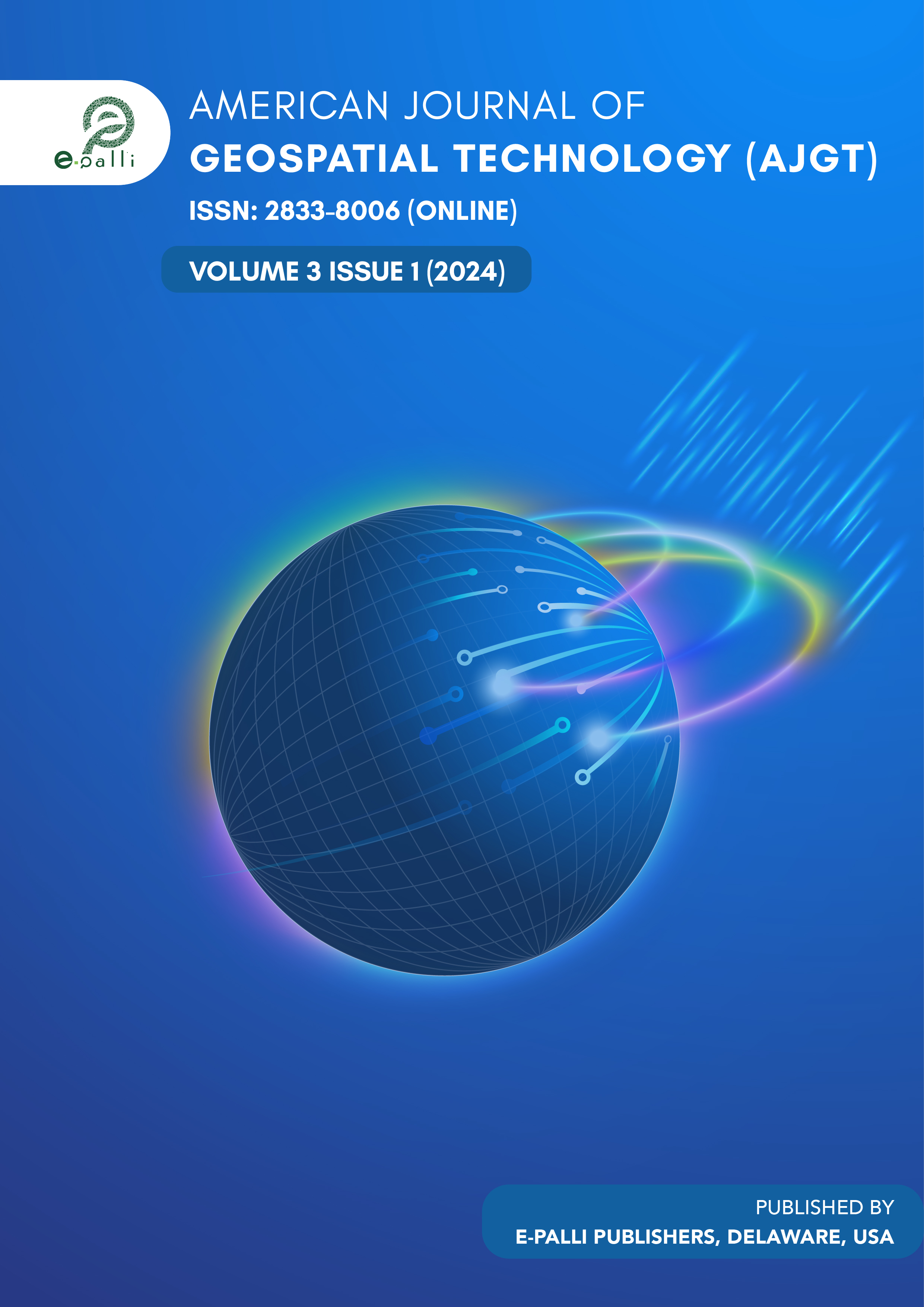GIS and Artificial Intelligence Application in Smart Forest Ecosystem Sustainability Evaluation of Olokemeji Forest Reserve, Ogun State, Nigeria
DOI:
https://doi.org/10.54536/ajgt.v3i1.2621Keywords:
Geographic Information Systems (GIS), Artificial Intelligence (AI), Convolution Neural Network (CNN), Normalized Difference Vegetation Index (NDVI), Satellite ImageryAbstract
The increase in human population over the years has accelerated growth in anthropogenic activities, which have led to the conversion of forest reserves to other land uses. In the sequel, it has become imperative for researchers to focus on the mapping of forest reserves through the use of GIS and Artificial Intelligence (AI) with time-efficient, automated, and low-cost methods to preserve the existing forest reserve and its sustainability evaluation implementation. This research aimed at utilizing GIS and artificial intelligence applications in smart forest ecosystem sustainability evaluation of Olokemeji forest reserve, Ogun State, with the following objectives: (i.) assessment of the current state of the forest ecosystem.(ii.) identify potential threats and risks to the study area and (iii.) develop sustainable management strategies for its conservation and preservation. In pursuance of this, GIS and AI were deployed in this study to assess the spatial characteristics of the forest ecosystem in Olokemeji forest reserve. Landsat imagery, ground coordinates, and a research questionnaire were the major data used. Object-based classification, Normalized Difference Vegetation Index (NDVI), and Land Use Land Cover in ArcGIS 10.2 software was deployed in data generation and analysis. The results showed that in 2013, about 1657.115 ha of the study area was occupied by dense forest cover while in 2023, it decreased to 1188.060 ha, with a difference of about 469.055 ha. By implementing smart forest monitoring and evaluation systems that use artificial intelligence, the government and commercial groups should set regulations focused on reducing the escalating risks to forest reserves.
References
Afroz, T., Miah, M. G., Abdullah, H. M., & Islam, M. R. (2022). Monitoring of LULC changes and forest loss using geospatial technique: A case study from northern region of Bangladesh, American Journal of Geospatial Technology, 1(2), 1-9. https://doi.org/10.54536/ajgt.v1i2.907
Agbo-Adediran, O. A., Olajire-Ajayi, B., Olokeogun, O. S., & Bolanle-Ojo, O. T. (2016). Floristic Composition of the Restricted Zone in Olokemeji Forest Reserve. In Proceedings of NTBA/NSCB Joint.
Aigbokhan, O. J., Ogoliegbune, O. M., Essien, N. E., Mshelia, Z. H., & Okumodi, B. O. (2022). Spatio-Temporal Mapping of Wetland Ecosystem in Abeokuta North Local Government Area, Nigeria. Zaria Geographer, 29(1).
Amoah, A., & Korle, K. (2020). Forest depletion in Ghana: The empirical evidence and associated driver intensities. Forestry Economics Review, 2(1), 61-80. https://doi.org/10.1108/FER-12-2019-0020
Brinkhoff, T. (2022). Ogun State, Nigeria Population. Retrieved February 19, 2024, from https://citypopulation.de/en/nigeria/admin/NGA028__ogun/.
Corbett, J., & Mellouli, S. (2017). Winning the SDG battle in cities: How an integrated information ecosystem can contribute to the achievement of the 2030 sustainable development goals. Information Systems Journal, 27(4), 427–461. https://doi.org/10.1111/isj.12138
González-Vélez, J. C., Torres-Madronero, M. C., Murillo-Escobar, J., & Jaramillo-Fayad, J. C. (2021). An artificial intelligent framework for prediction of wildlife vehicle collision hotspots based on geographic information systems and multispectral imagery. Ecological Informatics, 63, 101291. https://doi.org/10.1016/j.ecoinf.2021.101291
Holzinger, A., Keiblinger, K., Holub, P., Zatloukal, K., & Müller, H. (2023). AI for life: Trends in artificial intelligence for biotechnology. New Biotechnology, 74, 16–24. https://doi.org/10.1016/j.nbt.2023.02.001
Hopkins, B. (1965). Vegetation of the Olokemeji Forest Reserve, Nigeria: II. The Climate with special reference to its seasonal changes. Ecology, 53(1), 109-123. British Ecological Society.
Jahani, A., Feghhi, J., Makhdoum, M. F., & Omid, M. (2016). Optimized forest degradation model (OFDM): An environmental decision support system for environmental impact assessment using an artificial neural network. Journal of Environmental Planning and Management, 59(2), 222–244. https://doi.org/10.1080/09640568.2015.1005732
Kayode, A. S., Emmanuel, A. B., Babatunde, A. N., & Sola, A. J. (2023). Combination of GIS, MCDA and AHP for the selection of most suitable location for primary health care facilities. American Journal of Geospatial Technology, 2(1), 1-6. https://doi.org/10.54536/ajgt.v2i1.1820
Kyere-Boateng, R., & Marek, M. V. (2021). Analysis of the Social-Ecological Causes of Deforestation and Forest Degradation in Ghana: Application of the DPSIR Framework. Forests, 12(4), 409. https://doi.org/10.3390/f12040409
Liu, T., Yang, X., Batchelor, W. D., Liu, Z., Zhang, Z., Wan, N., Sun, S., He, B., Gao, J., Bai, F., Zhang, F., & Zhao, J. (2020). A case study of climate-smart management in foxtail millet (Setaria italica) production under future climate change in Lishu county of Jilin, China. Agricultural and Forest Meteorology, 292–293, 108131. https://doi.org/10.1016/j.agrformet.2020.108131
Liu, Z., Peng, C., Work, T., Candau, J.-N., DesRochers, A., & Kneeshaw, D. (2018). Application of machine-learning methods in forest ecology: Recent progress and future challenges. Environmental Reviews, 26(4), 339–350. https://doi.org/10.1139/er-2018-0034
Morgan, E. (2022). Deforestation on the rise as poverty soars in Nigeria. Retrieved from https://www.weforum.org/agenda/2022/03/deforestation-on-the-rise-as-poverty-soars-in-nigeria/
Nitoslawski, S. A., Galle, N. J., Van Den Bosch, C. K., & Steenberg, J. W. N. (2019). Smarter ecosystems for smarter cities? A review of trends, technologies, and turning points for smart urban forestry. Sustainable Cities and Society, 51, 101770. https://doi.org/10.1016/j.scs.2019.101770
Nivanya, M. (2024). Nanonets: The Complete Guide to AI Image Processing. Retrieved from https://nanonets.com/blog/ai-image-processing/#ai-image-processing-software-alternatives
Oyediji, O. T., & Adenika, O. A. (2022). Forest Degradation and Deforestation in Nigeria; Poverty Link. International Journal of Multidisciplinary Research and Analysis, 5, 2837-2880. https://doi.org/10.47191/ijmra/v5-i10-35
Ogundele, F. O., & Odewunmi, G. (2012). Bedrock Geodesy, Physical and Physio-chemical properties of teak plantation soil in southwest Nigeria. Journal of Geography Geology, 4(3), 56-68.
Ogunleye, A. J., Adeola, A. O., Ojo, l. O., & Aduradola, A. M. (2004). Impact of farming activities on vegetation in Olokemeji Forest Reserve, Nigeria. Global Nest: The International Journal, 6(2), 130-139.
Pei, T., Xu, J., Liu, Y., Huang, X., Zhang, L., Dong, W., Qin, C., Song, C., Gong, J., & Zhou, C. (2021). GIScience and remote sensing in natural resource and environmental research: Status quo and future perspectives. Geography and Sustainability, 2(3), 207–215. https://doi.org/10.1016/j.geosus.2021.08.004
Salem, B. B. (2003). Application of GIS to biodiversity monitoring. Journal of Arid Environments, 54(1), 91–114. https://doi.org/10.1006/jare.2001.0887
Wilson, E. D. (1922). The Mazatzal quartzite, a new pre-Cambrian formation of central Arizona. M.S. thesis, University of Arizona
Yin, X., Li, J., Kadry, S. N., & Sanz-Prieto, I. (2021). Artificial intelligence assisted intelligent planning framework for environmental restoration of terrestrial ecosystems. Environmental Impact Assessment Review, 86, 106493. https://doi.org/10.1016/j.eiar.2020.106493
Zhang, Q., Chen, C., Wang, J., Yang, D., Zhang, Y., Wang, Z., & Gao, M. (2020). The spatial granularity effect, changing landscape patterns, and suitable landscape metrics in the Three Gorges Reservoir Area, 1995–2015. Ecological Indicators, 114, 106259. https://doi.org/10.1016/j.ecolind.2020.106259
Downloads
Published
How to Cite
Issue
Section
License
Copyright (c) 2024 Victor Ayodele Ijaware

This work is licensed under a Creative Commons Attribution 4.0 International License.











